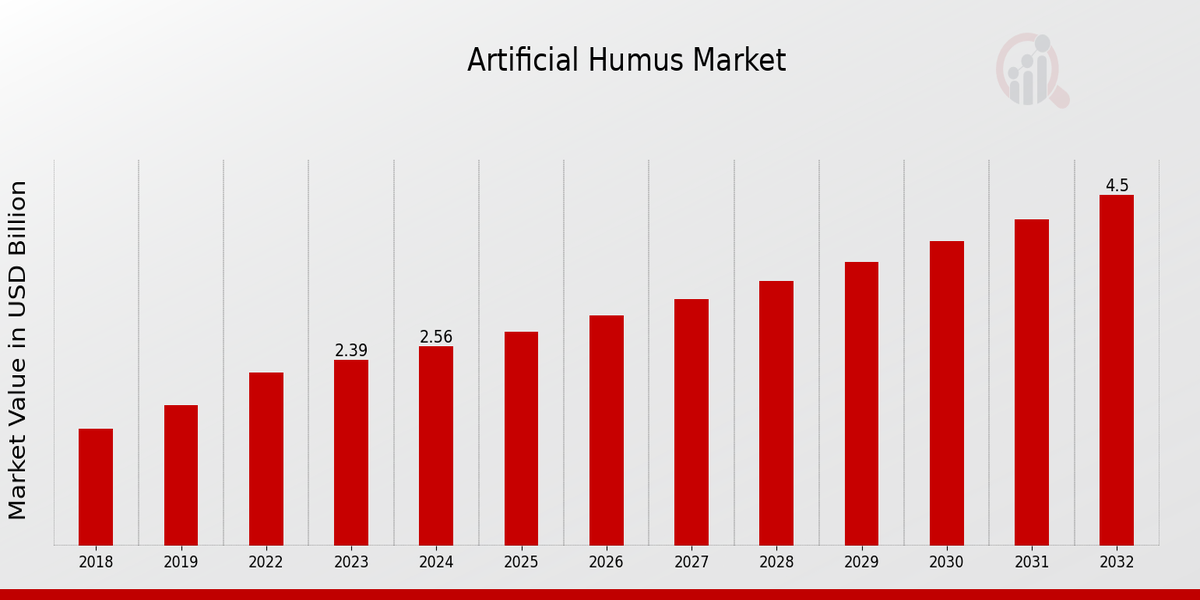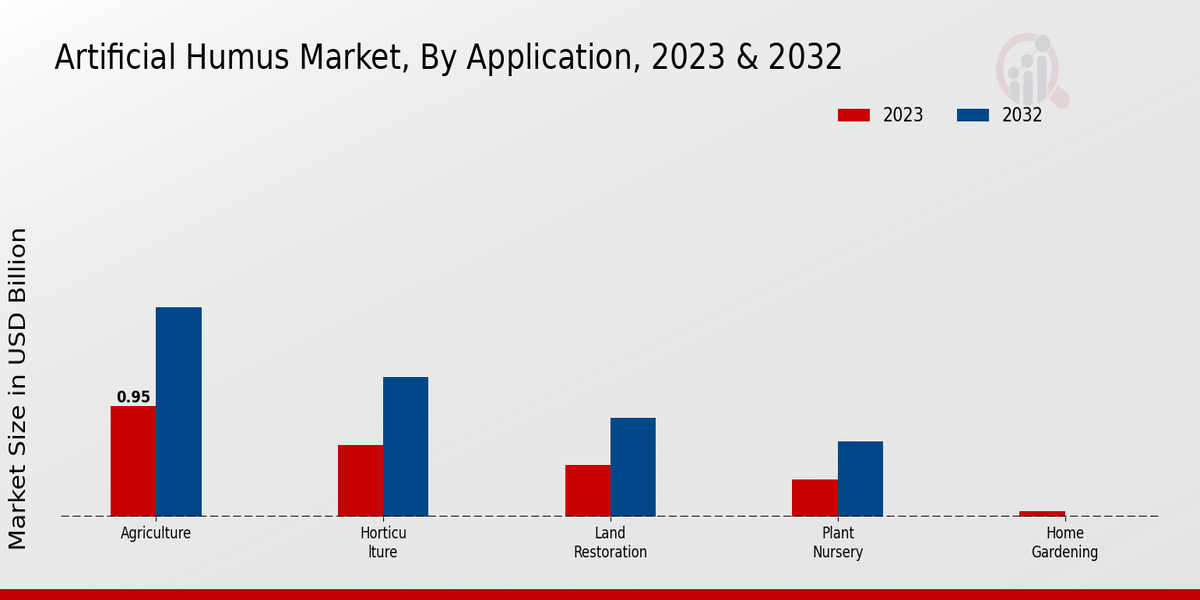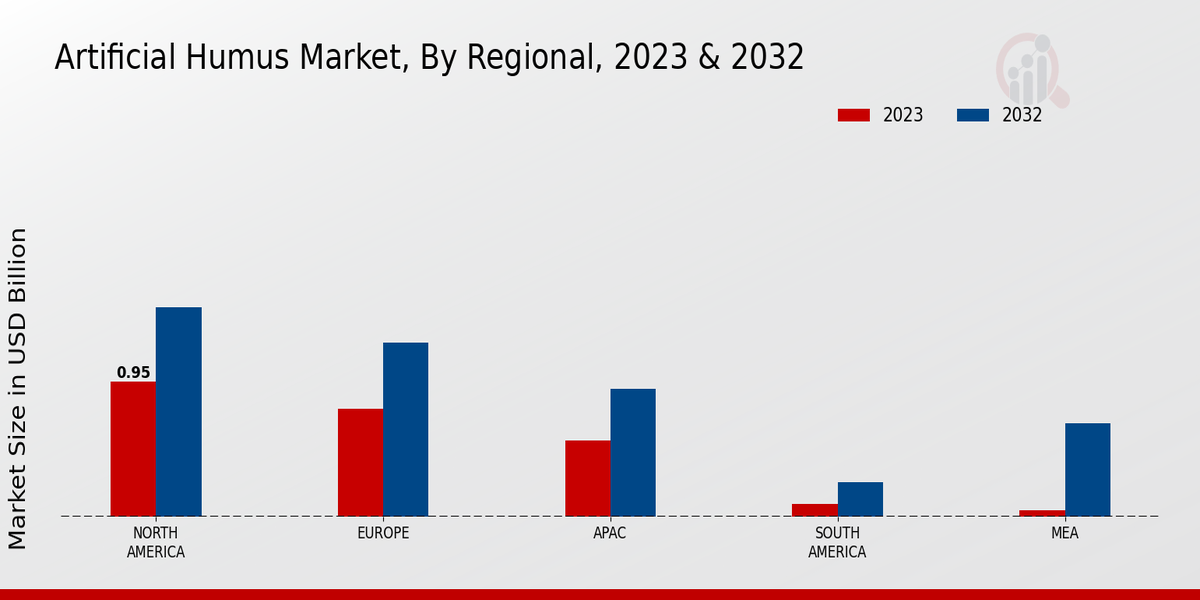Global Artificial Humus Market Overview
The Artificial Humus Market Size was estimated at 2.22 (USD Billion) in 2022. The Artificial Humus Industry is expected to grow from 2.39 (USD Billion) in 2023 to 4.5 (USD Billion) by 2032. The Artificial Humus Market CAGR (growth rate) is expected to be around 7.3% during the forecast period (2024 - 2032).
Key Artificial Humus Market Trends Highlighted
The Artificial Humus Market is driven by several key factors, notably rising awareness about soil health and sustainability in agriculture. As consumers and industries become more conscious of environmental issues, the demand for solutions that enhance soil fertility and promote sustainable farming practices has grown. This trend is supported by the need for efficient waste management and the promotion of organic farming methods. Many agricultural producers are increasingly adopting artificial humus to improve crop yields while reducing reliance on chemical fertilizers, thus aligning with eco-friendly practices. There are numerous opportunities to be explored within this expanding market, particularly in developing regions where agricultural practices are evolving.The increasing adoption of precision agriculture techniques presents a significant opening for products that can enhance soil quality and overall crop production efficiency. Furthermore, collaborations between agricultural technology companies and manufacturers of artificial humus can lead to innovative solutions tailored to specific farming needs. These partnerships may also pave the way for new distribution channels, making artificial humus more accessible to farmers ly. Recent trends indicate a growing preference for organic solutions among consumers, which is influencing the agricultural sector to adopt products like artificial humus more readily.The integration of technology in agriculture, such as the use of drones and soil sensors, also supports the application and effectiveness of artificial humus. Sustainability initiatives led by governments and organizations are further fueling this trend, prompting a shift toward regenerative agriculture practices. As this market continues to evolve, stakeholders are likely to encounter both challenges and opportunities that will shape its future trajectory.

Source: Primary Research, Secondary Research, MRFR Database and Analyst Review
Artificial Humus Market Drivers
Rising Population and Food Demand
The significant increase in the population is one of the most prominent drivers for the Artificial Humus Market Industry. As more people inhabit the planet, the demand for food continues to rise exponentially. This increased demand necessitates innovative agricultural practices and solutions to ensure food security. Artificial humus plays a vital role in enhancing soil fertility, improving crop yields, and promoting sustainable farming practices.With the ongoing challenges posed by climate change, soil degradation, and urbanization, artificial humus provides an effective solution to restore nutrient levels in the soil, making it an essential component in modern agriculture. Farmers and agricultural professionals are increasingly turning to artificial humus to meet their growing needs for productive and sustainable farming. This shift towards enhancing soil quality will contribute significantly to the growth of the Artificial Humus Market Industry as stakeholders seek to ensure that agricultural practices can keep pace with the ever-growing food requirements of a burgeoning population.
Sustainability and Organic Farming Trends
There is a growing emphasis on sustainability and organic farming practices worldwide, driving the demand for artificial humus. Consumers are increasingly aware of the impact of conventional farming on the environment and are advocating for products that are environmentally friendly. This shift towards organic farming promotes the use of artificial humus as it is often derived from recycled organic materials, helping to improve soil health without the harmful effects associated with synthetic fertilizers.The Artificial Humus Market Industry is seeing growth as farmers adopt more sustainable practices to meet consumer demands for organic produce.
Technological Advancements in Agriculture
Advancements in agricultural technologies are fueling the demand for artificial humus. Innovative farming techniques such as precision agriculture, hydroponics, and vertical farming have gained popularity, allowing for more efficient use of resources. Artificial humus complements these technologies by providing essential nutrients for plant growth and improving soil structure. As the agricultural sector embraces technology-driven solutions, the Artificial Humus Market Industry is set to benefit significantly from these developments, with an increasing number of farmers incorporating artificial humus into their operations.
Artificial Humus Market Segment Insights
Artificial Humus Market Application Insights
The Artificial Humus Market is experiencing substantial growth, with the Application segment being a critical area. In 2023, the market was valued at 2.39 USD Billion and is projected to reach 4.5 USD Billion by 2032, reflecting a robust growth trajectory. The segmentation within this market highlights several key areas: Agriculture, Horticulture, Land Restoration, Plant Nursery, and Home Gardening. The Agriculture sector is notably significant, valued at 0.95 USD Billion in 2023 and expected to rise to 1.8 USD Billion by 2032. This dominance is attributable to the increasing demand for sustainable farming practices and the need for enhanced soil health, which drives the adoption of artificial humus as a vital soil amendment.Horticulture also represents a crucial aspect of the market, valued at 0.62 USD Billion in 2023, with a future valuation of 1.2 USD Billion anticipated by 2032. The importance of artificial humus in horticulture cannot be overstated, as it promotes better plant growth and yields, enhancing the overall quality of flowers and ornamental plants. Land Restoration is another significant area, currently valued at 0.45 USD Billion and projected to reach 0.85 USD Billion in the forthcoming years. This segment underscores the growing focus on environmental sustainability and the revitalization of degraded land, making artificial humus a necessary component for effective soil restoration efforts.The Plant Nursery sector demonstrates a market value of 0.32 USD Billion in 2023, expected to grow to 0.65 USD Billion by 2032. This growth highlights the increasing importance of artificial humus in a controlled environment where quality soil is paramount for nurturing various plant species. Lastly, the Home Gardening segment, despite being the smallest with a value of 0.05 USD Billion in 2023, illustrates the rising trend of urban gardening and the demand for quality soil products among hobbyist gardeners. However, this segment is expected to hold steady with limited growth potential compared to the other segments, reflecting a more niche market. The Artificial Humus Market data indicates that each application area has its peculiar challenges and opportunities. The trend toward organic farming and eco-friendly gardening solutions enhances the attractiveness of artificial humus, with industry statistics showing a clear shift in consumer preferences towards sustainable practices. Overall, the Application segment is witnessing significant changes driven by market growth across diverse areas, each contributing equally but further emphasizing the importance of artificial humus in modern agriculture and horticultural practices.

Source: Primary Research, Secondary Research, MRFR Database and Analyst Review
Artificial Humus Market Source Material Insights
The Source Material segment of the Artificial Humus Market plays a critical role in the overall growth of the industry, contributing significantly to the expected market value of 2.39 USD Billion in 2023, and is on course for further growth. Each source material contributes uniquely, with Sewage Sludge being vital due to its nutrient-rich properties, while Animal Manure serves as an organic fertilizer, reconnecting the agricultural cycle. Crop Residues are also essential as they enhance soil fertility and structure, helping in the sustainable management of waste.Food Waste has emerged as a sustainable resource, reducing environmental burden while enriching soil quality. Furthermore, Wood Chips are gaining traction, providing organic matter and improving soil aeration. Overall, the placement of these materials within the Artificial Humus Market segmentation demonstrates their importance in addressing both agricultural needs and environmental concerns, showcasing their essentiality in driving market growth amid increasing demand for sustainable farming practices.
Artificial Humus Market Form Insights
The Artificial Humus Market, particularly in the Form segment, is experiencing significant growth, with the overall market valued at 2.39 billion USD in 2023 and anticipated to reach 4.5 billion USD by 2032. The segmentation into various forms, such as Granular, Liquid, Powder, Tiles, and Pellets, showcases the versatility and adaptability of artificial humus products. Granular forms are often preferred for their convenience and effectiveness in soil enrichment, while Liquid products offer ease of application and quick nutrient release, which makes them highly sought after in urban farming.Powder forms provide a concentrated option suitable for customers looking for maximum nutrient density. Additionally, Tiles and Pellets serve as innovative solutions that cater to specific agricultural needs, emphasizing a growing trend toward customized soil enhancement. The market trends highlight a shift towards eco-friendly solutions, motivating producers to innovate continuously and address challenges like cost-effectiveness and accessibility, ultimately influencing Artificial Humus Market data and statistics positively.
Artificial Humus Market Distribution Channel Insights
The Artificial Humus Market is projected to reach a valuation of 2.39 USD Billion in 2023, indicating robust growth driven by increasing demand for sustainable agriculture practices. Within the Distribution Channel framework, the market encompasses various pathways, including Online, Offline, Retail Stores, Wholesale, and Direct Sales, each playing a crucial role in delivering artificial humus products to end users. Online distribution channels are gaining traction due to the convenience and wider reach they offer to consumers, while Retail Stores hold significant importance by providing direct access to purchasers.Wholesale channels contribute to bulk sales, catering to large-scale agricultural operations and commercial users, thereby dominating a substantial share of the market. Direct Sales also maintain relevance as they facilitate direct interaction between producers and consumers, fostering trust and loyalty. The diversity in Distribution Channels enhances the accessibility and availability of artificial humus products, driving the overall market growth and addressing various consumer preferences within the Artificial Humus Market industry. The statistics surrounding these distribution avenues reflect a dynamic landscape, with evolving trends toward digitalization and an increasing focus on sustainable farming solutions shaping their development.
Artificial Humus Market Regional Insights
The Artificial Humus Market is projected to experience significant growth across its regional segments, contributing to an overall valuation of 2.39 USD Billion in 2023. North America emerges as a major player, holding a valuation of 0.95 USD Billion in 2023 and expected to grow to 1.473 USD Billion by 2032, indicating its dominance in the market. Europe follows closely with a valuation of 0.76 USD Billion in 2023 and a future valuation of 1.227 USD Billion, reflecting its significant role in the Artificial Humus Market. The APAC segment, valued at 0.54 USD Billion in 2023, has growth potential and is expected to reach 0.9 USD Billion by 2032, driven by increasing agricultural activities and environmental awareness.South America and MEA hold smaller market shares, valued at 0.09 USD Billion and 0.05 USD Billion in 2023, respectively, but are poised for growth in relevance, especially with rising demand for sustainable farming practices. The diverse market growth across these regions indicates not only the opportunities but also the challenges in addressing local agricultural needs and sustainability targets, highlighting the broad scope for innovation and market expansion within the Artificial Humus Market revenue.

Source: Primary Research, Secondary Research, MRFR Database and Analyst Review
Artificial Humus Market Key Players and Competitive Insights
The Artificial Humus Market is witnessing a significant evolution characterized by the growing demand for sustainable agricultural practices and the need for enhanced soil fertility. As the agricultural sector increasingly embraces environmentally friendly solutions, the competition within the market has intensified, with numerous players vying for market share through innovative products and strategic partnerships. The diversity of offerings, ranging from organic-based fertilizers to synthetic blends designed to mimic the nutrient profile of natural humus, enhances market dynamics. Companies in this sector are focusing on research and development to improve existing formulations and introduce new ones that cater to specific crop requirements. Additionally, the rise of e-commerce platforms has transformed distribution channels, providing competitive advantages for companies that can adapt quickly to these changes.AgriTech Producers has positioned itself as a robust contender in the Artificial Humus Market through its commitment to sustainable practices and the development of high-quality humus products. The company has established a strong market presence, leveraging its innovative technologies that enhance soil health and crop yield. By focusing on research and utilizing cutting-edge agricultural science, AgriTech Producers has cultivated a reputation for reliability and effectiveness in its product offerings. Its strengths lie in its extensive distribution network, which ensures a wide reach to farmers and agricultural businesses worldwide. Additionally, the brand’s emphasis on customer relationships and education helps to solidify loyalty in an increasingly crowded market, allowing AgriTech Producers to maintain a competitive edge amidst evolving consumer preferences.Humintech has made notable strides in the Artificial Humus Market, emphasizing the critical role of humic substances in improving soil structure and nutrient uptake. The company is renowned for its production methods that highlight sustainability and environmental responsibility, setting it apart from conventional fertilizer producers. Humintech’s portfolio includes a variety of advanced humic products designed to cater to different soil and crop types. The company’s strengths are evident in its robust research and development initiatives, which continuously refine its offerings to meet the changing needs of farmers and the agricultural industry. Additionally, Humintech’s outreach through strategic collaborations and partnerships enables it to penetrate various regional markets effectively, enhancing its visibility and influence in the sector. The brand is also committed to ongoing education and support for its users, fostering a strong community of farmers who recognize the value of using humic products for long-term soil health and farming success.
Key Companies in the Artificial Humus Market Include
- AgriTech Producers
- Humintech
- Soil Biomediation
- Agro Engineering
- Hawthorne Gardening Company
- TerraCycle
- Nature's Way
- Soil Nutrients
- Sustainable Organic Solutions
- Gufl Organic
- Green America Recycling
- Fertile Soil
- Organic Matters
- BioChar Products
Artificial Humus Market Industry Developments
Recent developments in the Artificial Humus Market highlight an increasing focus on sustainable agricultural practices. Companies such as AgriTech Producers and Humintech are expanding their product lines to include innovative humus-based fertilizers that enhance soil health and boost crop yields while appealing to environmentally conscious consumers. Soil Biomediation and Agro Engineering are collaborating on new research projects aimed at integrating advanced biotechnologies into artificial humus production, which is expected to significantly improve efficiency and reduce environmental impact.The Hawthorne Gardening Company and TerraCycle are advancing circular economy initiatives, utilizing waste materials to produce organic humus, thereby reducing reliance on conventional fertilizers. Additionally, notable mergers and acquisitions involving companies like Nature's Way and Soil Nutrients are reshaping market dynamics, fostering increased competition and innovation throughout the sector. Organic Matters and Fertile Soil are also gaining traction, with strong growth in market valuation reflecting the rising demand for sustainable soil enhancers. This shift is driving significant investments into research and development, further solidifying the role of artificial humus in the agricultural landscape.
Artificial Humus Market Segmentation Insights
Artificial Humus Market Application Outlook
- Agriculture
- Horticulture
- Land Restoration
- Plant Nursery
- Home Gardening
Artificial Humus Market Source Material Outlook
- Sewage Sludge
- Animal Manure
- Crop Residues
- Food Waste
- Wood Chips
Artificial Humus Market Form Outlook
- Granular
- Liquid
- Powder
- Tiles
- Pellets
Artificial Humus Market Distribution Channel Outlook
- Online
- Offline
- Retail Stores
- Wholesale
- Direct Sales
Artificial Humus Market Regional Outlook
- North America
- Europe
- South America
- Asia Pacific
- Middle East and Africa
| Report Attribute/Metric |
Details |
| Market Size 2022 |
2.22 (USD Billion) |
| Market Size 2023 |
2.39 (USD Billion) |
| Market Size 2032 |
4.5 (USD Billion) |
| Compound Annual Growth Rate (CAGR) |
7.3% (2024 - 2032) |
| Report Coverage |
Revenue Forecast, Competitive Landscape, Growth Factors, and Trends |
| Base Year |
2023 |
| Market Forecast Period |
2024 - 2032 |
| Historical Data |
2019 - 2023 |
| Market Forecast Units |
USD Billion |
| Key Companies Profiled |
AgriTech Producers, Humintech, Soil Biomediation, Agro Engineering, Hawthorne Gardening Company, TerraCycle, Nature's Way, Soil Nutrients, Sustainable Organic Solutions, Gufl Organic, Green America Recycling, Fertile Soil, Organic Matters, BioChar Products |
| Segments Covered |
Application, Source Material, Form, Distribution Channel, Regional |
| Key Market Opportunities |
Sustainable agriculture practices adoption, Rising demand for organic farming, Urban gardening and landscape enhancement, Technological advancements in production, Government support for soil health initiatives |
| Key Market Dynamics |
Growing demand for sustainable agriculture, Increasing awareness of soil health, Rise in organic farming practices, Government support for green initiatives, Development of advanced production techniques |
| Countries Covered |
North America, Europe, APAC, South America, MEA |
Frequently Asked Questions (FAQ) :
The Artificial Humus Market is expected to be valued at 4.5 USD Billion in 2032.
The expected CAGR for the Artificial Humus Market from 2024 to 2032 is 7.3%.
North America is projected to hold the largest market share, valued at 1.473 USD Billion in 2032.
The market value for the Artificial Humus Market in Agriculture is expected to be 1.8 USD Billion in 2032.
Major players in the Artificial Humus Market include AgriTech Producers, Humintech, and TerraCycle.
The Artificial Humus Market is expected to be valued at 2.39 USD Billion in 2023.
The market value for Horticulture in the Artificial Humus Market is expected to be 1.2 USD Billion in 2032.
The APAC region is expected to grow and reach a market value of 0.9 USD Billion by 2032.
The market size for Home Gardening is expected to remain at 0.0 USD Billion by 2032.
The market presents growth opportunities driven by sustainable farming practices and challenges relating to environmental regulations.





























